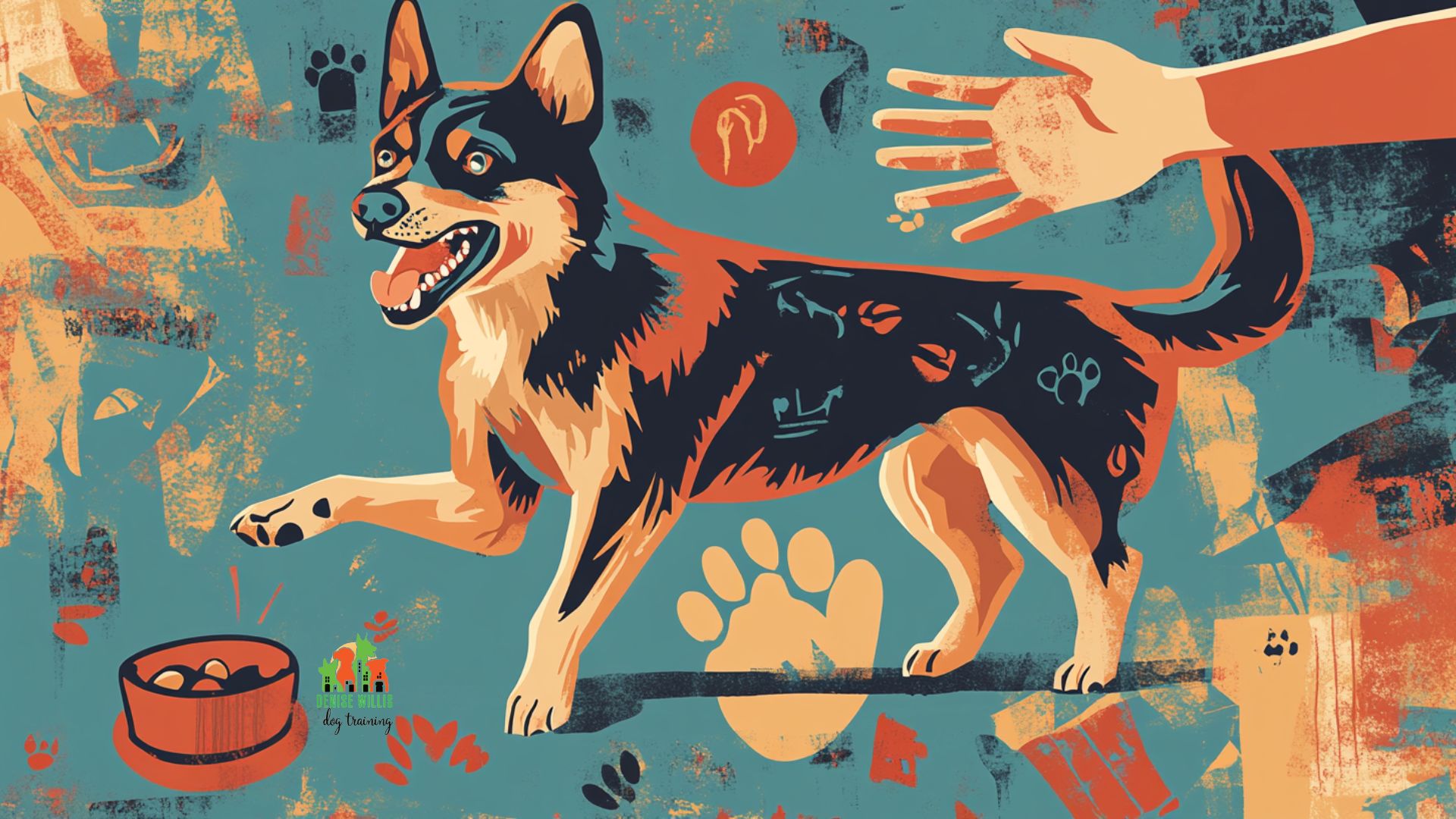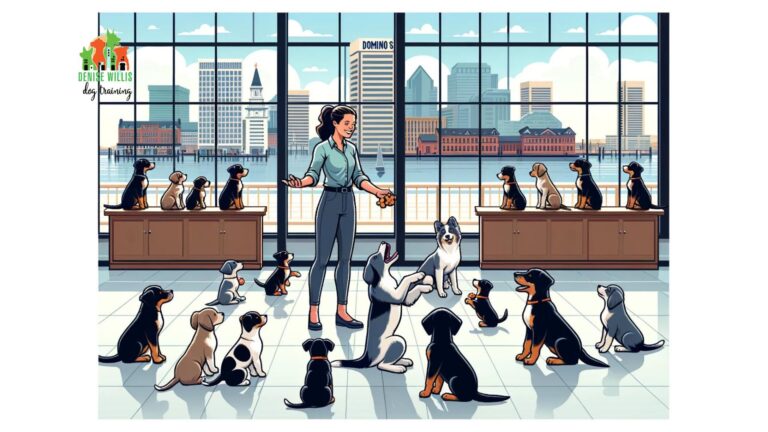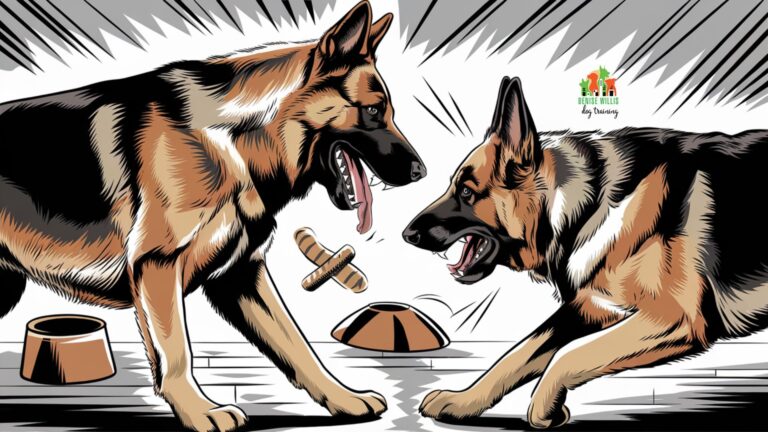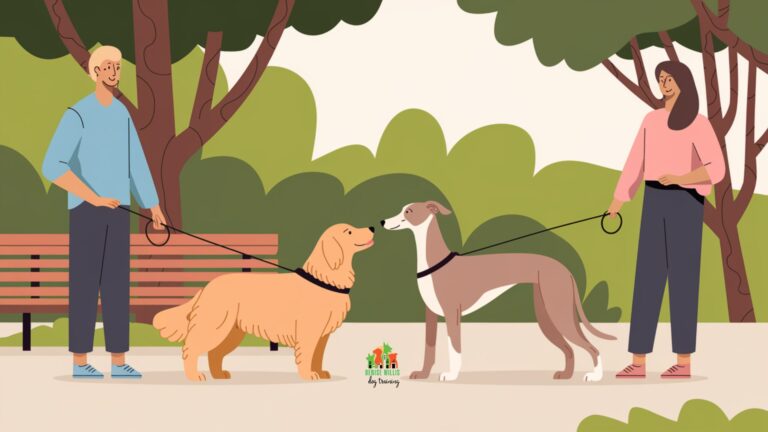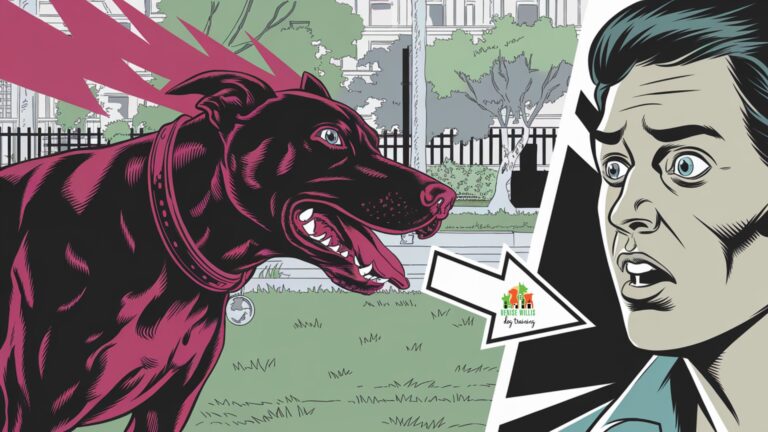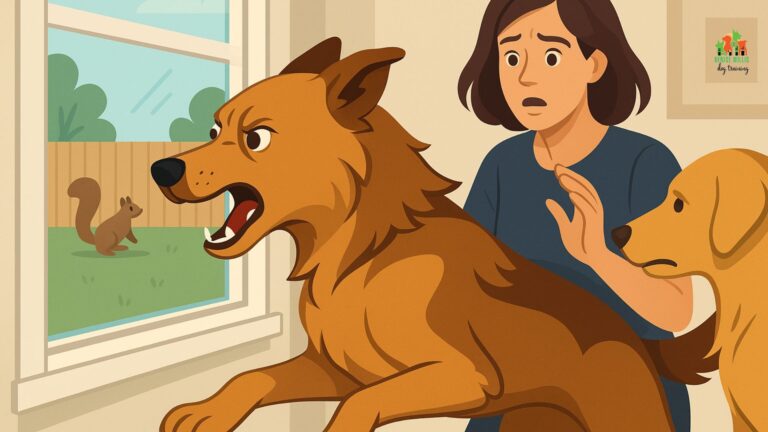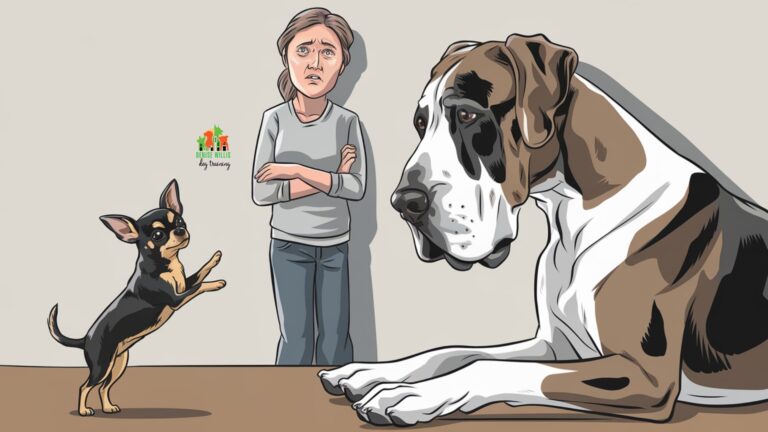10 Warning Signs Your Dog Might Bite (and How to Prevent It)
📍 Service Area Notice: DW Dog Training provides in-person training services exclusively in the Greater Baltimore area. While our blog content is designed to help dog owners internationally, our hands-on training services are locally focused. For readers outside our service area, we hope you find value in our articles and welcome you to reach out with questions!
Is your dog showing signs of aggression towards humans?
Let me tell you, it’s a heart-stopping moment when your furry best friend suddenly turns into Cujo. Trust me, I’ve been there – dragged down an icy sidewalk by my 110-pound German Shepherd, nursing a bruised ego and a newfound determination to understand what makes our canine companions tick.
But here’s the thing: dog aggression isn’t a life sentence. It’s often rooted in fear, anxiety, or past experiences, and with the right approach, we can turn that snarling Cerberus into a sociable sweetheart. Stick around, and I’ll share the ten warning signs your dog might bite, along with proven strategies to prevent it.
By the time we’re done, you’ll be reading your dog like a book – a very furry, possibly drool-covered book, but a book nonetheless!
Key Takeaways
- Dog aggression isn’t a life sentence – it’s often rooted in fear, anxiety, or past experiences.
- There are clear warning signs before a bite – learn them, love them, live by them.
- Prevention is your best friend – socialization and positive training are key.
- Respect the dog’s space – even if it’s your own pup, sometimes they need a timeout.
- Age matters – older dogs are more prone to aggression, often due to medical issues.
- Size doesn’t – small dogs can be just as aggressive as big ones.
- Professional help isn’t admitting defeat – it’s being a responsible pet parent.
- Your behavior affects your dog’s – stay calm, be consistent, and lead by example.
- Medical issues can cause aggression – when in doubt, visit the vet.
- Every dog deserves a chance – with patience and the right approach, most aggressive behaviors can be improved.
4 Key Warning Signs of Dog Aggression
Growling
A clear vocal warning sign that the dog is uncomfortable or feeling threatened.
Showing Teeth
Baring teeth is a sign of aggression and a warning to back off.
Stiff Posture
A rigid body stance indicates the dog is on high alert and may react aggressively.
Raised Hackles
Fur standing up along the back indicates arousal and potential aggression.
Understanding Dog Aggression
Dog aggression isn’t just your pup waking up one day and deciding to be a jerk (though sometimes it might feel that way). It’s a complex issue with a whole bunch of potential causes.
First things first, let’s talk about what’s going on in that furry little head. Dogs, believe it or not, aren’t plotting world domination when they show aggression. Most of the time, they’re scared, anxious, or trying to protect something they value. It’s like that time I found a spider in my shower – I wasn’t trying to be aggressive, I was just terrified and trying to protect my personal space (and dignity).
Common causes of aggression include:
- Fear: The number one culprit. A scared dog is like a teenager at their first school dance – awkward, defensive, and prone to lashing out.
- Lack of socialization: If your dog hasn’t met many humans or other dogs, everyone’s a stranger, and strangers are scary.
- Past trauma: Dogs have long memories, especially for bad experiences. One nasty encounter can lead to a lifetime of “stranger danger” reactions.
- Pain or medical issues: A hurting dog is a grumpy dog. It’s like when you stub your toe and suddenly the whole world is your enemy.
- Resource guarding: Some dogs are the canine equivalent of that kid who never learned to share. They might get aggressive to protect their food, toys, or even you!
Now, here’s where it gets interesting. Certain factors can increase the likelihood of aggression:
- Age: As dogs get older, they’re more likely to show aggressive behaviors. It’s like they hit their grumpy old man phase.
- Sex: Sorry, boys, but male dogs tend to be more aggressive than females. It’s not you, it’s your testosterone.
- Size: Here’s a surprise – smaller dogs are often more aggressive than larger breeds. It’s like they’re trying to compensate for something. Napoleon complex, anyone?
- Living situation: Dogs in single-dog households are more prone to aggression. Turns out, having a furry sibling can teach you some manners.
- Owner experience: Inexperienced owners might unknowingly reinforce aggressive behaviors. It’s not your fault – dogs don’t come with an instruction manual!
Types of aggression are like flavors of ice cream – there’s more than you’d expect, and some are less pleasant than others:
- Fear-based aggression: The most common type. It’s the dog equivalent of “I’m not scared, you’re scared!”
- Territorial aggression: This is when your dog thinks they’re guarding Fort Knox, but it’s just your front yard.
- Possessive aggression: Also known as resource guarding. Suddenly, that ratty old tennis ball is worth more than gold.
- Protective aggression: When your dog decides they’re your personal bodyguard. Flattering, but not always helpful.
- Pain-induced aggression: Because nobody likes to be touched when they’re hurting.
- Redirected aggression: When a dog can’t reach the source of its frustration and decides to take it out on whatever (or whoever) is closest.
Understanding these types and causes of aggression is like having a secret decoder ring for your dog’s behavior. It’s the first step in turning that growl into a tail wag.
Interactive Timeline: Understanding and Addressing Dog Aggression
Early Puppyhood (0-14 weeks)
Critical socialization period. Lack of proper socialization during this time can lead to fear and aggression later in life.
Adolescence to Early Adulthood (1-3 years)
Inter-dog aggression often appears between 1-3 years of age. Social maturity occurs around 18-36 months, which can trigger aggression related to social status.
Adulthood (3+ years)
Aggression risk tends to increase with age. Older dogs are more prone to aggression, possibly due to increased risk of painful conditions.
Prevention Strategies
Implement socialization, positive reinforcement training, and create safe spaces for your dog throughout their life.
Recognizing Warning Signs
Learn to identify signs of potential aggression such as growling, showing teeth, and stiff body language.
Professional Help
Seek assistance from certified dog behaviorists or trainers if aggressive behaviors persist or worsen.
10 Warning Signs Your Dog Might Bite
Alright, folks, it’s time to put on your detective hats. We’re about to dive into the world of canine body language. Think of it as learning a new language, except instead of “Where’s the bathroom?” you’re trying to understand “Are you about to turn my hand into a chew toy?”
- The Growl: This is the doggy equivalent of “Back off, buddy!” It’s your dog’s way of saying they’re uncomfortable. Don’t punish them for growling – it’s actually a good thing! They’re warning you instead of going straight for the chomp.
- Showing Teeth: If your dog’s lips curl back to reveal their pearly whites, they’re not smiling for the camera. This is a clear sign that they’re feeling threatened and might be ready to defend themselves.
- The Freeze: If your dog suddenly goes still as a statue, it’s not because they’re playing a game. This stiff, frozen posture is often a precursor to aggression. Think of it as the calm before the storm.
- The Stare-Down: A hard, intense stare is not your dog’s way of gazing lovingly into your eyes. It’s a challenge, and it’s best not to meet it head-on. In dog language, a stare is rude and confrontational.
- Raised Hackles: When the fur along your dog’s back stands up, it’s not because they’re trying out a new hairstyle. This is a sign of arousal, and not the good kind. They’re on high alert and potentially ready to react.
- Tail Talk: A tail held high and stiff is a sign of a dog on alert and potentially ready to aggress. On the flip side, a tail tucked between the legs can indicate fear, which can also lead to defensive aggression.
- Ear Action: If your dog’s ears are pulled back flat against their head, they’re telling you they’re scared or submissive. But be careful – a scared dog can quickly become an aggressive dog if they feel cornered.
- The Yawn or Lip Lick: Contrary to what you might think, these aren’t always signs of tiredness or hunger. In stressful situations, dogs may yawn or lick their lips as a calming signal. It’s their way of saying, “I’m feeling uncomfortable here.”
- The Cringe: If your dog is cowering, trying to make themselves look small, or trembling, they’re scared out of their wits. A scared dog is often an unpredictable dog, so give them space.
- The Whale Eye: This is when you can see the whites of your dog’s eyes, usually because they’re looking at something without moving their head. It’s often a sign of anxiety and discomfort.
Now, here’s the tricky part: these signs often happen in combination, and they can escalate quickly. It’s like a doggy version of those “Choose Your Own Adventure” books, except every wrong choice could end with a bite.
Remember, dogs are usually trying their best to communicate with us. They don’t want to bite any more than we want to be bitten. By learning to read these signs, you’re not just protecting yourself – you’re also making life less stressful for your furry friend.
And here’s a pro tip: if you’re ever unsure about a dog’s behavior, err on the side of caution. It’s better to be overly cautious than to end up needing a tetanus shot. Trust me, I’ve been there, and it’s not fun explaining to the doctor that you got bitten because you thought the growling dog just wanted a belly rub.
Types of Dog Aggression: Prevalence
| Aggression Type | Prevalence (%) |
|---|
Prevention Strategies
Alright, now that we’ve covered the warning signs, let’s talk about how to prevent things from getting to that point in the first place. Think of this as your toolkit for raising a happy, well-adjusted pup who’s more likely to lick faces than bite them.
Socialization: The Golden Ticket
First up, socialization. This is the big kahuna of prevention strategies. Imagine if you’d never met another human until you were an adult – pretty scary, right? Same for dogs. The key is to expose your pup to a wide variety of people, animals, and situations during their critical socialization period (that’s before they’re 14 weeks old, folks).
Take your puppy everywhere you can. Let them meet people of all ages, sizes, and ethnicities. Introduce them to other animals (safely, of course – we’re not trying to recreate Noah’s Ark here). The more positive experiences they have early on, the less likely they are to react with fear or aggression later in life.
But here’s the catch – socialization doesn’t stop when puppyhood ends. Keep those positive experiences coming throughout your dog’s life. It’s like maintaining a friendship – you can’t just meet someone once and expect to be BFFs forever.
Positive Reinforcement: Because Treats Work Better Than Threats
Next up, training. And I’m not talking about the old-school “dominate your dog” nonsense. We’re talking positive reinforcement, people. This means rewarding good behavior instead of punishing bad behavior.
Think about it – would you rather work for someone who gives you a bonus when you do well, or someone who docks your pay when you mess up? Dogs are the same way. Reward the behaviors you want to see more of, and you’ll get more of those behaviors.
Use treats, praise, toys, or whatever your dog loves. The key is to make good behavior more rewarding than bad behavior. And remember, consistency is key. If you let your dog jump on people sometimes but not others, you’re just confusing the poor pup.
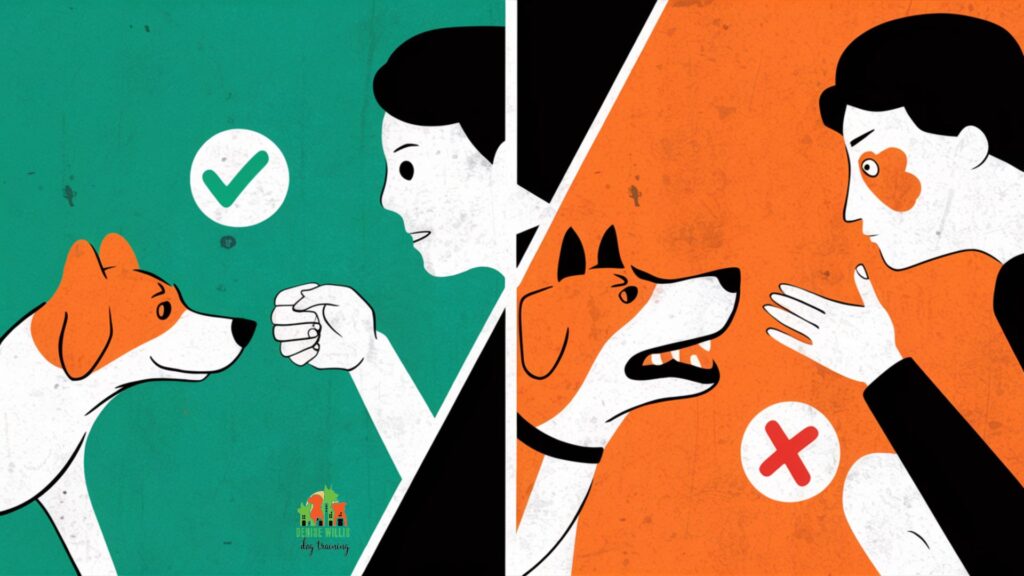
Body Language: Becoming a Doggy Detective
Remember those warning signs we talked about earlier? Well, prevention isn’t just about recognizing when your dog is about to bite – it’s about noticing when they’re starting to feel uncomfortable and addressing it before it escalates.
Learn to read your dog’s body language. Are they licking their lips a lot? Yawning when they’re not tired? Turning their head away? These could be early signs of stress or discomfort. By recognizing these signals early, you can remove your dog from stressful situations before they feel the need to growl or snap.
Safe Spaces: Everyone Needs a Timeout Sometimes
Create a safe space for your dog. This could be a crate, a bed in a quiet corner, or a whole room if you’re feeling fancy. The point is to have a place where your dog can retreat when they’re feeling overwhelmed.
Teach everyone in the household (especially kids) to leave the dog alone when they’re in their safe space. It’s like having a “Do Not Disturb” sign, but for dogs.
Professional Help: Because Google Can’t Solve Everything
Look, I know we all like to think we’re experts after watching a few dog training videos on YouTube. But sometimes, you need to call in the big guns. If your dog is showing signs of aggression, don’t wait – get help from a certified dog behaviorist or trainer.
These folks have seen it all, and they can give you personalized advice based on your specific situation. Plus, they can spot issues that you might be too close to see. It’s like going to a therapist, but for your dog (and let’s be honest, sometimes for you too).
Remember, seeking help isn’t a sign of failure – it’s a sign that you’re a responsible pet owner who wants the best for their furry friend. And trust me, it’s a lot less stressful than trying to figure it all out on your own while your dog turns every walk into a WWE smackdown.
What to Do If You Encounter an Aggressive Dog
Alright, picture this: you’re out for a nice, peaceful walk, maybe whistling a little tune, when suddenly you find yourself face-to-face with a dog that looks like it wants to audition for the next Cujo movie. What do you do? Don’t worry, I’ve got you covered.
Stay Calm (Even If You’re Screaming Inside)
First things first, take a deep breath. I know, I know, easier said than done when you’re staring down a set of gnashing teeth. But here’s the thing: dogs can smell fear. Okay, not literally, but they are experts at reading body language, and if you’re panicking, they’ll pick up on it.
Try to remain as calm as possible. Don’t make any sudden movements. Pretend you’re auditioning for a role as a statue. A very calm, non-threatening statue.
Avoid Eye Contact: This Isn’t a Staring Contest
In the dog world, direct eye contact is a challenge. It’s like walking into a biker bar and shouting, “Who wants a piece of me?” Not a great idea. Instead, look slightly to the side or at the ground. You want to appear non-threatening.
No Sudden Movements: You’re Not in an Action Movie
This isn’t the time to show off your fancy footwork or ninja moves. Avoid any sudden movements that might startle or provoke the dog. Move slowly and deliberately if you need to move at all.
Use Your Words (But Not Too Loudly)
If you can, try speaking to the dog in a calm, soothing voice. Something like, “Good dog, nice dog, please don’t eat me.” Okay, maybe not that last part. The point is to sound non-threatening. Don’t shout or scream – that’ll just amp up the tension.
The Art of Distraction
If you happen to have something you can use as a distraction, now’s the time. This could be a treat if you’re a person who randomly carries dog treats (no judgment here), or even a stick or toy. Toss it away from you – the idea is to give the dog something else to focus on that isn’t you.
Back Away Slowly: This Isn’t a Sprint
When it’s safe to do so, start backing away slowly. Don’t turn your back on the dog – remember, you’re not in a horror movie. Just take slow, careful steps backward until you’re at a safe distance.
Protect Yourself If Needed
If the worst happens and the dog attacks, try to put something between you and the dog. This could be a jacket, a bag, or even a stick. The goal is to give the dog something to bite that isn’t your flesh.
Aim for the sensitive areas if you need to defend yourself – the nose, eyes, or throat. I know it sounds harsh, but remember, we’re talking worst-case scenario here.
After the Encounter: Deep Breaths and Maybe a Stiff Drink
Once you’re safe, take some time to calm down. Aggressive dog encounters can be scary, and it’s normal to feel shaken up. Report the incident to the appropriate authorities if necessary, especially if it’s a loose dog in a public area.
And hey, if you need to ugly cry once you’re home safe, no judgment here. Sometimes a good cry and a pint of ice cream is just what the doctor ordered after a scary encounter.
Remember, most dogs don’t want to attack. They’re usually just scared, confused, or trying to protect themselves or their territory. By staying calm and non-threatening, you’re giving both yourself and the dog the best chance of walking away unscathed.
The Role of Dog Owners in Preventing Aggression
Alright, fellow dog parents, it’s time for some real talk. As much as we’d like to believe our furry friends are perfect angels, the truth is, preventing aggression starts with us. Yep, you heard that right – it’s on us to set our pups up for success. So, let’s roll up our sleeves and dig into what we can do to raise happy, well-adjusted canine citizens.
Consistency is Key (Even When You’re Tired and Just Want to Watch Netflix)
First things first, consistency. I know, I know, it’s not the sexiest word in the dog training world, but trust me, it’s the foundation of good behavior. Think of it like this: if sometimes you let your dog jump on people because it’s “cute” and other times you scold them for it, you’re basically giving them the canine version of whiplash.
Set clear rules and stick to them. If the rule is “no dogs on the couch,” then it’s no dogs on the couch even when you’re having a bad day and Fido’s giving you those irresistible puppy eyes. Your dog will thank you for the clarity (okay, maybe not thank you, but they’ll be less confused and stressed).
Exercise: It’s Not Just for Gym Rats
You know that saying, “A tired dog is a good dog”? Well, it’s not just a cute phrase to put on coffee mugs. Regular exercise is crucial for preventing aggression. A dog with pent-up energy is like a ticking time bomb of bad behavior.
But here’s the kicker – it’s not just about physical exercise. Mental stimulation is just as important. Puzzle toys, training sessions, even a good game of hide-and-seek can work wonders. Think of it as taking your dog to the gym and the library in one go.
Health Checks: Because Sometimes It’s Not Them, It’s Their Thyroid
Remember how we talked about pain or medical issues causing aggression? Well, this is where regular vet check-ups come in handy. Sometimes, what looks like aggression could be your dog’s way of saying, “Hey, my hip hurts!” or “My thyroid’s out of whack!”
Don’t skip those annual check-ups, and if you notice any sudden behavior changes, get them checked out pronto. It’s better to be safe than sorry, and your vet will appreciate not having to play detective with months of built-up symptoms.
Know Your Breed (But Don’t Use It as an Excuse)
Look, I’m not here to start any breed wars, but the truth is, different breeds can have different tendencies. If you’ve got a herding dog, don’t be surprised if they try to herd your kids. If you’ve got a guard dog breed, they might be a little more suspicious of strangers.
But here’s the important part: knowing breed tendencies doesn’t mean accepting unwanted behavior. It just means you know what you might need to work on. No matter what breed you have, with proper training and socialization, they can be a well-behaved member of society.
Lead by Example: Be the Person Your Dog Thinks You Are
Dogs are constantly watching us and picking up on our energy. If you’re anxious and jumpy every time you see another dog on a walk, guess what? Your dog’s going to pick up on that and think there’s something to be worried about.
Try to project calm, confident energy. I know, easier said than done, especially if you’ve had bad experiences in the past. But remember, your dog is looking to you for cues on how to behave. Be the leader they need you to be.
Socialize, Socialize, Socialize (And Then Socialize Some More)
I know we talked about this in the prevention strategies, but it bears repeating. Socialization isn’t just for puppies. Your dog should be having positive interactions with people, other animals, and new environments throughout their life.
But here’s the keyword: positive. Don’t just throw your dog into overwhelming situations and hope for the best. Start small, use lots of treats and praise, and gradually work up to more challenging scenarios.
Know When to Call in the Pros
Listen, there’s no shame in asking for help. If you’re struggling with your dog’s behavior, don’t wait until someone gets bitten to seek professional help. A good trainer or behaviorist can give you the tools you need to nip problems in the bud.
And remember, not all trainers are created equal. Look for someone who uses positive, science-based methods. Avoid anyone who talks about “dominance” or suggests harsh punishments. Your goal is to build a better relationship with your dog, not to break their spirit.
Test Your Knowledge: Dog Aggression Quiz
Frequently Asked Questions
Q: Can aggression in dogs be cured completely?
A: Oh, if I had a dollar for every time I’ve been asked this! Here’s the deal: “cured” is a strong word. It’s not like we can wave a magic wand and poof! – your formerly growly Grover is suddenly the life of the doggy party. But here’s the good news: with proper training, management, and sometimes a little help from our veterinary friends, most dogs can show significant improvement in their aggressive behaviors.
The goal isn’t to turn your dog into a saint (let’s face it, even we humans have our grumpy days). The aim is to make your dog comfortable and manageable in situations that used to trigger them. It’s about progress, not perfection.
Q: How long does it take to see improvements in my dog’s aggressive behavior?
A: Ah, the million-dollar question! If only dog training came with a precise timeline, right? The truth is, it varies. Some dogs might show improvement in a few weeks, while others might take months. It depends on factors like the severity of the aggression, the root cause, how consistent you are with training, and let’s face it, your dog’s individual personality.
Remember, we’re not running a sprint here – it’s more like a marathon. Sometimes you might feel like you’re taking two steps forward and one step back. That’s normal! The key is to celebrate the small victories and keep at it.
Q: Is it safe to use a muzzle on my aggressive dog?
A: Muzzles often get a bad rap, but when used properly, they can be a safe and effective tool. Think of it like a seatbelt for your dog – it’s not about punishment, it’s about safety.
But here’s the important part: a muzzle is not a substitute for training. It’s a management tool to use while you’re working on the underlying issues. And for the love of all things furry, please introduce the muzzle properly! We don’t want your dog thinking it’s some kind of face-eating monster.
Q: Can neutering or spaying help reduce aggression in dogs?
A: This one’s a bit of a mixed bag. For some dogs, especially males with hormone-driven aggression, neutering can help. But it’s not a guaranteed fix-all solution. It’s like taking away the matches from a pyromaniac – it might help, but you still need to address the underlying desire to start fires, if you catch my drift.
If aggression is rooted in fear or anxiety, simply neutering or spaying isn’t likely to solve the problem on its own. It’s just one piece of the puzzle.
Q: Are certain breeds more prone to aggression?
A: Oh boy, this is a touchy subject! While some breeds might have a higher tendency towards certain behaviors, individual personality, upbringing, and experiences play a much larger role in determining a dog’s behavior.
It’s like how not every teenager with a skateboard is a delinquent – stereotypes only get you so far. Any dog, regardless of breed, can be aggressive if they’re not properly socialized, trained, or if they’re in pain or scared.
The takeaway? Don’t judge a dog by its breed. Judge it by its behavior and how its owners have raised and trained it.
Product Recommendations to Help with Dog Aggression
Alright, let’s talk gear. Now, I’m not saying these products are magic wands that’ll solve all your problems, but they can certainly be helpful tools in your “preventing dog aggression” toolkit. Remember, always consult with a professional before introducing new training tools, especially if you’re dealing with aggression issues.
- ThunderShirt Classic Dog Anxiety Jacket: Think of this as a constant hug for your anxious pup. It uses gentle, constant pressure to help calm dogs in stressful situations. I’ve seen it work wonders for dogs with anxiety-based aggression.
- PetSafe Gentle Leader Head Collar: This gives you better control during walks, which can be a game-changer for reactive dogs. It’s like power steering for your dog – it guides their attention back to you when they start to get overstimulated.
- KONG Classic Dog Toy: Never underestimate the power of distraction! A KONG filled with tasty treats can keep your dog mentally stimulated and less likely to engage in problematic behaviors. Plus, it’s just plain fun to watch them try to get the treats out.
- Zesty Paws Calming Bites for Dogs: These natural supplements may help reduce anxiety-driven aggression. Think of it as doggy chill pills. Always check with your vet before starting any supplement regimen.
- Adaptil Calm Home Diffuser for Dogs: This diffuser releases calming pheromones that can help reduce stress-related behaviors. It’s like aromatherapy for dogs, except they actually respond to it (unlike my attempts to use lavender to calm my hyperactive terrier).
Remember, these products are aids, not solutions. They work best when used in conjunction with proper training and behavior modification techniques. And as always, if you’re dealing with serious aggression issues, please consult with a professional. Your dog (and your neighbors) will thank you!
Further Reading
Alright, knowledge seekers, if you’re hungry for more info (and let’s face it, when it comes to our furry friends, aren’t we always?), I’ve got some great articles for you to sink your teeth into. These pieces dive deeper into specific aspects of dog behavior and training, giving you more tools to understand and help your four-legged friend.
- 5 Proven Strategies to Stop Your Dog’s Aggression Towards Other Dogs If your pup is more “Cujo” than “Lassie” around other dogs, this article is for you. It’s packed with practical strategies to help your dog become a better canine citizen.
- Decoding Your Dog: 15 Body Language Signals You Need to Know Ever wish your dog came with subtitles? This article is the next best thing. Learn to read your dog’s body language like a pro.
- How to Manage Your Dog’s Territorial Aggression If your dog thinks they’re the bouncer at Club Backyard, this article will help you manage their territorial tendencies.
- 10 Proven Techniques to Tame Your Aggressive Puppy Puppies are cute, but they can also be little land sharks. Learn how to nip those aggressive behaviors in the bud.
- Dog Aggression Toward Children: Understanding the Root Causes and Effective Solutions If you’ve got kids (or your dog is likely to encounter them), this is a must-read. Learn how to keep both your two-legged and four-legged family members safe and happy.
These articles will help you dig deeper into the world of dog behavior and training. Remember, knowledge is power, especially when it comes to understanding and helping our furry friends. Happy reading, and here’s to creating a happier, healthier relationship with your canine companion!
Final Thoughts
Whew! We’ve covered a lot of ground here, haven’t we? From decoding doggy body language to becoming a zen master of calm energy, you’re now armed with a veritable Swiss Army knife of knowledge to tackle dog aggression.
Remember, folks, aggression in dogs isn’t a life sentence. It’s not about having a “bad dog” – it’s about a dog who’s trying their best to communicate their discomfort or fear in the only way they know how. Our job as responsible pet parents is to be their translator, their guide, and sometimes their superhero.
The journey to helping an aggressive dog isn’t always easy. There will be days when you wonder why you didn’t just get a goldfish. But trust me, the bond you’ll build with your furry friend through this process is worth every frustrating moment.
Key things to keep in mind:
- Prevention is always better than cure. Socialize early and often!
- Consistency is your best friend. Dogs thrive on routine and clear expectations.
- Don’t be afraid to ask for help. Professional trainers and behaviorists are there for a reason.
- Remember, it’s a process. Celebrate the small victories along the way.
- Above all, keep yourself and others safe. Management is just as important as training.
At the end of the day, we’re not just training dogs – we’re building relationships. Every growl transformed into a tail wag, every successful walk past another dog, every calm reaction to a stressful situation – these are the building blocks of a stronger bond between you and your furry friend.
But here’s the thing: you don’t have to go it alone. At DW Dog Training, we’ve been in the trenches with countless dogs and their humans, helping them navigate the choppy waters of aggression. We’ve seen it all, from the tiniest Chihuahua with a Napoleon complex to the gentlest giant who suddenly turns into Cujo at the dog park.
And you know what? We’ve helped them all.
Our personalized training programs are designed to address your specific situation. We don’t just treat the symptoms; we get to the root of the problem. Whether it’s fear-based aggression, resource guarding, or any other form of aggressive behavior, we have the tools and experience to help you and your furry friend find a path forward.
So, if you’re struggling with your dog’s aggressive behavior, don’t wait until someone gets bitten to seek help. Reach out to us at DW Dog Training. You can contact us through our website. Let’s work together to turn those growls into tail wags and those tense walks into enjoyable adventures.
Now, I’d love to hear from you.
Dealing with dog aggression can be a tough, emotional journey.
How has it been for you? What challenges have you faced? What victories, no matter how small, have you celebrated?
Your experiences and insights could be incredibly valuable to other dog owners facing similar challenges. Drop a comment below and let’s keep this conversation going. Remember, you’re not alone in this – we’re all in this together, working towards happier, healthier relationships with our four-legged friends.
So, here’s to wagging tails, happy barks, and peaceful walks in your future. You’ve got this, and remember, your dog is lucky to have someone who cares enough to learn and grow with them.
Now, go give your pup a belly rub from me. Even if they’re currently guarding the sofa like it’s Fort Knox – baby steps, right?
We Want to Hear From You!
Alright, we’ve covered a lot of ground here, but the conversation doesn’t have to end! Your experiences, questions, and insights are incredibly valuable, not just to us, but to other dog owners who might be facing similar challenges.
So, let’s keep this discussion going!
- Share Your Story: Have you dealt with dog aggression before? What worked for you? What didn’t? Your story could be the beacon of hope that another struggling dog owner needs right now.
- Got Questions? Did this article spark any questions in your mind? Maybe you’re wondering how to apply these strategies to your specific situation, or perhaps you have a unique challenge we didn’t cover. Don’t be shy – ask away!
- What’s Your Take? We’ve shared our proven strategies, but we know there’s always more to learn. What do you think about these approaches? Do you have any additional tips or tricks that have worked wonders for your pup?
- Need Clarification? Was there a part of the article that left you scratching your head? Let us know! We’re here to help, and we can always expand on topics that need more explanation.
- Success Stories Welcome! If you’ve already implemented some of these strategies and seen positive results, we want to hear about it! Your success story could be the motivation someone else needs to take that first step.
Remember, addressing dog aggression is a journey, and every journey is unique. By sharing our experiences and knowledge, we create a supportive community that benefits dogs and owners alike. So don’t be a stranger – let’s keep this conversation going!
Leave your comments, questions, or stories below, or reach out to us directly if you prefer. We’re all in this together, and together, we can help create a world of happier, more sociable dogs!

